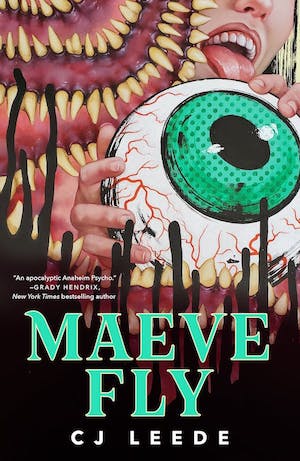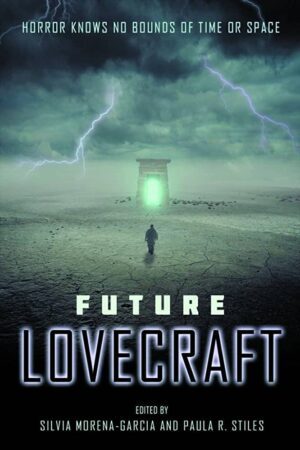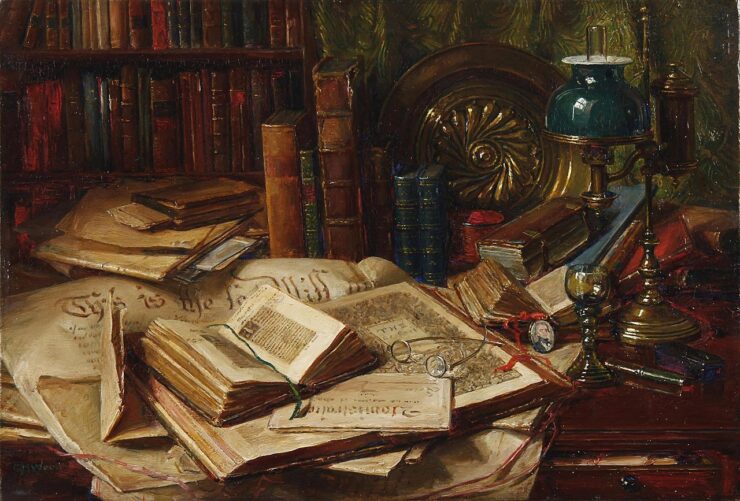Welcome back to Reading the Weird, in which we get girl cooties all over weird fiction, cosmic horror, and Lovecraftiana—from its historical roots through its most recent branches.
This week, we cover Molly Tanzer’s “Go, Go, Go, Said the Byakee,” first published in Silvia Moreno-Garcia and Paula R Stiles’s Future Lovecraft in 2011. You may be able to find it more easily in Nick Mamatas’s Wonder and Glory Forever anthology. Spoilers ahead!
“Stag-Face said those places were holy, because if you looked at them too long, or thought about them too hard while you were there, you’d get a nosebleed, and that was the sign of the Mother in the Salt.”
Dicle has many interesting associates. Wriggler lives in the lake and has “long, bendy arms.” If you’re nice, he may bring up good things to eat. Feathers lives in a treetop hut and may throw down the highest fruit, or may just squawk over imagined slights. Whee! swings through the trees with his fuzzy tail. Mr. Pinch has a claw on his extra arm. Stag-Face has a deer’s head and is the boss. These people get to dance in the nightly revels, but not Dicle. She’s still a “two-legs two-hands two-eyes upright skin-wearer,” a kid assigned the worst chores, like emptying piss-pots or digging corpses out of earthquake-collapsed caves, as once she dug out her Mama.
Dicle retains her boring cradle-name, but her budding mammalian protuberances and dreams of snuggling with Wriggler are signs she’s ready for the pilgrimage to Tuz Gölü, where the Mother in the Salt gives her children their true shapes and names. Stag-Face says she’s too young, but she makes a secret plan with confidant Wriggler, who catches food for her journey. She packs her mother’s bones, with which the Mother in the Salt should be so pleased she’ll change Dicle into the fastest ever, and then Dicle can come home and snuggle with Wriggler and everything will be wonderful.
Early one morning Dicle sets off, a knife strapped to her arm to warn off wood-beasties and ghouls. Her path is of “cracked black stuff,” smoothed by countless travelers. Like everybody, she knows that “time and space were the same thing, except where they weren’t.” Some places around K’pah-doh-K’yah you avoid. Trees there grow “backwards in time” and could gobble you up. If you look too long at these holy places, you’ll get a nosebleed, sure sign of the Mother in the Salt. Also, if you have a baby inside, it will grow so fast it tears you open. Then the baby will become a ghoul, always hungry.
Dicle runs fast through the Mother-places, which multiply the closer she gets to Tuz Golu. The trees disappear. Salt coats her lips. At last, she crests a hill and stands between the white-hot sky and the white-bright valley where the Mother’s altar rises: a huge rectangular box beside a pale lake. Poles jut from its top, holding up a “big empty circle.” So strange, but Dicle’s only concern must be climbing the sacred stair to the top of the altar.
As she runs towards it, two figures appear. One drags the other, who is missing half a leg and screaming. The two look just like Dicle, but so old that they should have changed by now. The dragger screams there’s something in the lake. Of course there is, Dicle says. Don’t they know it’s the Mother?
They don’t seem to know anything. The screamer dies. The dragger collapses. “But we just left yesterday,” she keeps saying, whatever that means. Dicle tries to comfort the stranger as Stag-Face comforted her when Mama died, demonstrating the correct death rituals by slicing a strip of meat from the corpse’s thigh and with its blood drawing the Mother’s insignia on the stranger’s forehead and her own. Then she gobbles up the meat.
Uncomforted, the stranger forbids Dicle from cleaning any more flesh off the corpse’s bones. Her name is Yildiz. Despite her general ignorance, she insists that Dicle’s village of K’pah-doh-K’yah is pronounced “Cappadocia” and that no one can be living there in caves, not since the “government’s” post-earthquake evacuations. The country they’re in is called “Turkey.” The pale lake is “an endorheic basin” meant to contain any runoff from the “Hypersaline Resonator” once part of the “Tuz Gölü Research Station.”
Dicle explains how music summoned the Mother, who at the same time was always present. How the Mother gives true shapes. How the Mother knows her children’s hearts and loves them all. How space and time are the same things. Then, wearying of Yildiz’s obtuseness, she drags her towards the altar. The Mother will explain things better.
As they reach the sacred stair, Stag-Face appears. He won’t stop Dicle this time! She races upward and places her mother’s bones under the big suspended circle. A lever stands ready. Stag-Face shouts that Dicle hasn’t purified her heart, the Mother won’t accept her for changing! As he charges, Yildiz shrieks he has a knife and fumbles something from her belt.
Dicle pulls the lever. Purple-blue lightning wreathes the suspended circle. Heat bursts behind Dicle, Stag-Face howls in pain, the salt on the altar begins to sing. The song’s so beautiful that Dicle’s heart shudders. Blood flows from her eyes, ears, and nose, signaling the Mother’s arrival.
Buy the Book


Maeve Fly
And Dicle prays, “harder than anyone ever prayed before.”
Yildiz comes to K’pah-doh-K’yah with Dicle, newly named Spots for her leopard-like appearance. She’s boss now, having killed Stag-Face with a “laser pistol.” She explains how she and “Ahmet” went through the Hypersaline Resonator thinking to visit a star in the sky. The Resonator was supposed to keep too much time from passing here while they were gone. Instead, at their destination they found this Mother, or a different one, she doesn’t know. They were afraid the Mother would follow them home, not understanding how the Mother loves all her children. Silly them. Now everything is better.
Dicle’s become Jackrabbit. The Mother’s made her fastest of all, but also the “scaredest.” She rarely leaves her hidey-hole. Noise torments her big ears. True, she can jump higher in the revels than anyone, but since her snuggle-partner Wriggler died, she hasn’t felt like reveling. Wriggler put a baby inside Jackrabbit, but when it came out and everyone crowded around to see, she was so scared she gobbled it up.
Being changed isn’t what she hoped for. She’s always frightened, and always alone, and nothing is wonderful at all.
What’s Cyclopean: Language has had time to change since the Mother’s coming, along with life itself. “Meat-shells” for bodies and “skin-wearer” for children living in them, a new pronunciation for Cappadocia. Some of the strange-seeming words, however, are recognizable Turkish: “bal1k” are fish, and “yengeç” are crabs.
Weirdbuilding: Travel to other worlds and you might find elder gods—or at least something that appreciates worship and technologically-aided summonings. We also get an alternate origin story for ghouls: fetuses in utero sped up by temporal anomalies, who come out from their mothers catastrophically fast and catastrophically hungry.
Ruthanna’s Commentary
Byakhee, first off, are interstellar predators sometimes used as steeds by people whose only problem with the void between stars is the distance—and not, say, the cold or lack of air. Per the H.P. Lovecraft Wiki, you can get around those inconvenient details by drinking “space mead”. They’re a creation of August Derleth, unless they’re the unnamed things that show up underground in “The Festival.” All this per the H.P. Lovecraft Wiki, because my willingness to read Derleth is extremely limited.
Byakhee are not known for enthusiastic shouting, and do not appear in recognizable form in this story. What does appear, as the story opens, is a quote from T.S. Eliot’s Four Quartets. And that quote is immediately preceded by:
Go, said the bird, for the leaves were full of children,
Hidden excitedly, containing laughter.
Go, go, go, said the bird.
So why a byakhee in place of the bird, rather than a mi-go or a nightgaunt? Voyages between stars and eagerness—perhaps too much eagerness—to move quickly are very much present. Dicle’s desire for transformation mirror’s Y1ld1z’s insufficiently-planned interstellar journey. “Go, go, go!” We seek change and innovation and disruption. We invent things and deal with the consequences later. The Manhattan Project team thought the risk of turning Earth into a newly-fused star was sufficiently low to take the risk; presumably the researchers at Tuz Gölü made similar calculations about the likelihood of summoning elder gods. We are all children, by this standard. At least until something new shows up and offers true adulthood, remaking the planet in its own image.
Or in something’s image, anyway. The most startling aspect of the story, when I think about it, is that the deeply unearthly Mother gives humans forms inspired by earthly animals. Perhaps She’s trying to understand her new home? And perhaps that’s why these transformations come with unpleasant—but thoroughly earthly—effects. Stag presumably wanted to be proud and beautiful, and got a stag’s temper alongside. Feather presumably identified a bit too much with some flightless bird, or else the Mother didn’t realize the importance of hollow bones for megafaunal flight. Wriggler dies after mating, squidlike. And jackrabbit has the prey-fear and tendency toward infanticide of her namesake. And the speed she prayed for. Go. Go. Go.
“If all time is eternally present,” says Eliot, “All time is unredeemable.”
I suppose it could be a deliberate monkey’s paw sort of a thing. But that seems like a much pettier motivation for the Mother than curiosity. Space tears open, strange tiny creatures spill out, and you find yourself pulled through in the other direction and stranded far from home. You’d want to figure out how everything works, right?
Back in our own universe, Tuz Gölü—once one of the largest hypersaline lakes in the world, and an excellent site for hypersalinity-dependent technobabble—is drying up and sometimes disappears entirely. (I spent an unreasonable time on Google trying to determine if it actually has water at the moment, and did not succeed.) This is a problem for extremophiles like flamingos. The civilization-morphing disruption of Mother’s arrival in 2011 would presumably have curtailed carbon emissions, to the lake’s benefit. Flamingos do well in near-boiling or hypersaline water, and so may be perfectly fine sharing Tuz Gölü with an elder god—provided she doesn’t like to eat their favorite shrimp. Or them.
Anne’s Commentary
Rest assured: No Byakhees were harmed during the production of Molly Tanzer’s “Go, Go, Go, Said the Byakee.” That’s because the story contains no Byakhee. In her website entry for November 28, 2011, Molly Tanzer owns up to this omission. Her inspiration was not the crow-mole-buzzard-ant monstrosity capable of manipulating the galactic magnetic field to travel at superlight speed through the vacuum of space. Instead she’s paying homage to Sonya Dorman’s “Go, Go, Go, Said the Bird,” first published in Dangerous Visions (1967). Dorman’s title is a quote from T. S. Eliot’s Four Quartets: Burnt Norton. Tanzer extends the quote in her epigraph (leaving out the first clause):
“Go, go, go, said the bird: human kind
Cannot bear very much reality.
Time past and time future
What might have been and what has been
Point to one end, which is always present.”
Still humaniform Dicle is Tanzer’s protagonist. That she’s also the narrator isn’t immediately apparent, given the story’s written in the third person rather than the first. It’s an effective way to demonstrate Dicle/Jackrabbit’s alienation from herself, um, her selves. Dicle is “what has been.” Jackrabbit is that “what might have been” wonderful, but which in the “always present” isn’t wonderful at all. In Dicle’s world, everyone knows that “time and space were the same thing, except when they weren’t.” Time is a tricky concept if you look at it too long or think about it too much, as Stag-Face warns against doing in the “Mother-places” dotted like sand hazards around K’pah-doh-K’yah. Better to accept that the Mother in the Salt has always been in Tuz Gölü, the vast hypersaline lake in Turkey’s Central Anatolia Region, and that she loves all her children and knows their hearts so well she can change each child from equivocal humanity to that shape that expresses them to perfection.
I guess this ultimate self-expression, as potentiated by the Mother, is a good thing. A wonderful thing, as Dicle expects post-change life to be.
Except when it isn’t. After all, what fun would a post-apocalyptic tale be if the apocalypse left everything wonderful?
It seems that in Dicle’s time and space, no one remembers what the apocalypse was, or, actually, that there ever was one. The Mother has always been beneath the Salt of Tuz Gölü, ready to transform the pious into creatures blissfully adapted to their environment. Bring an osseous offering. Pray hard. Presto, the bones’ former owner can rest in peace, and you will be Changed. All this is religion.
But one mustn’t forget to pull that lever-thingie on the altar. Now we’re edging into technology, because what’s more technological than a lever-thingie, especially when it makes a big circle-thingie start emitting purple-blue lightning? Enter, a few pages earlier, a character who can explain the science behind Tuz Gölü.
That’s Yildiz, a stranger from the past, when the Mother’s altar was the Tuz Gölü Research Station, home of the Hypersaline Resonator. The Resonator was located in a geological depression with water input but no outlet, so that any runoff from the facility wouldn’t get into rivers. Yildiz keeps muttering that she and Ahmet couldn’t have emerged in a far-future world like Dicle’s when they only departed Tuz Gölü yesterday. The Resonator was designed to counteract the time dilation that occurs at the kind of velocity sufficient for them to reach another star system with an inhabitable planet; it would keep too much time from passing on Earth while they were gone. Well, something major got screwed up. Probably it was the entity they encountered at their destination, which Yildiz-Become-Spots will realize was the Mother, or a Mother anyway. It must have followed them through the Resonator back to Earth, but being capable of instantaneous or near-instantaneous travel, it reached Earth first, creating that far-past apocalypse to the far-future effects of which they’ve returned.
Earlier, Dicle has unwittingly corroborated Yildiz-Spot’s explanation by saying “the music” brought the Mother. This music would be the beautiful “singing” the activated Resonator “circle” evokes from the “salt” naturally present in hypersaline Lake Tuz. When Dicle yanks the lever, the “singing” resummons the Mother, whose “sign” is hemorrhaging and mutation.
For Yildiz-Spots, mutation works out fine. She becomes the boss of K’pah-doh-K’yah in laser-killed Stag-Face’s stead. A fresh believer, she proclaims that the Mother’s coming was a good thing. For Dicle-Become-Jackrabbit, it’s a different story. She acquires the rabbit’s swiftness but also its anxious nature. From the boldest of children, she becomes the “scaredest” of adults. She and Wriggler become snugglers, but Wriggler’s mutation to octopoid form brings with it that creature’s post-mating descent into senescence and death. Jackrabbit’s left with child, but as an anxious rabbit may do, she eats her offspring directly after its birth.
Be careful what you wish for is right! But does the Mother care? Not if she’s the typical Mythosian “god.”
It just occurs to me that the Mother might be a sort of Byakhee, or at least share in their ability to traverse space and time at many times the speed of light! Which would mean there’s something pleasantly Byakhee-ish about this story, after all.
Next week, join us for Chapter 11 of Hilary Mantel’s Beyond Black.
Ruthanna Emrys is the author of A Half-Built Garden and the Innsmouth Legacy series, including Winter Tide and Deep Roots. You can find some of her fiction, weird and otherwise, on Tor.com, most recently “The Word of Flesh and Soul.” Ruthanna is online on Twitter and Patreon and on Mastodon as [email protected], and offline in a mysterious manor house with her large, chaotic household—mostly mammalian—outside Washington DC.
Anne M. Pillsworth’s short story “The Madonna of the Abattoir” appears on Tor.com. Her young adult Mythos novel, Summoned, is available from Tor Teen along with sequel Fathomless. She lives in Edgewood, a Victorian trolley car suburb of Providence, Rhode Island, uncomfortably near Joseph Curwen’s underground laboratory.














